Filippo Baldinucci was an Italian art historian and biographer.

Filippino Lippi was an Italian painter working in Florence, Italy during the later years of the Early Renaissance and first few years of the High Renaissance.

Cosimo I de' Medici was the second Duke of Florence from 1537 until 1569, when he became the first Grand Duke of Tuscany, a title he held until his death.

Domenico di Michelino (1417–1491) was an Italian Renaissance painter who was born and died in Florence. His real name was Domenico di Francesco. The patronymic "di Michelino" was adopted in honor of his teacher, the cassone painter Michelino di Benedetto, by whom no works have been identified. Giorgio Vasari reports that Domenico was also a pupil of Fra Angelico, whose influence is reflected in many of Domenico's paintings along with that of Filippo Lippi and Pesellino.
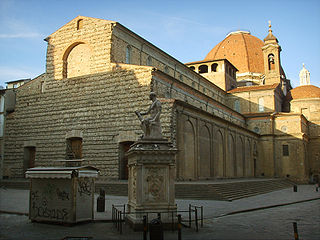
The Basilica di San Lorenzo is one of the largest churches of Florence, Italy, situated at the centre of the city’s main market district, and the burial place of all the principal members of the Medici family from Cosimo il Vecchio to Cosimo III. It is one of several churches that claim to be the oldest in Florence, having been consecrated in 393, at which time it stood outside the city walls. For three hundred years it was the city's cathedral before the official seat of the bishop was transferred to Santa Reparata.
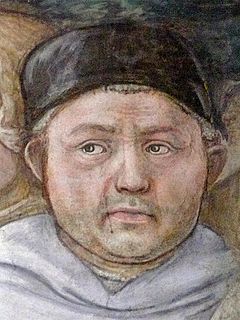
Fra'Filippo Lippi, also known as Lippo Lippi, was an Italian painter of the Quattrocento and a Carmelite Priest.

Giuliano da Sangallo was an Italian sculptor, architect and military engineer active during the Italian Renaissance. He is known primarily for being the favored architect of Lorenzo de' Medici, his patron. In this role, Giuliano designed a villa for Lorenzo as well as a monastery for Augustinians and a church where a miracle was said to have taken place. Additionally, Giuliano was commissioned to build multiple structures for Pope Julius II and Pope Leo X. Leon Battista Alberti and Filippo Brunelleschi heavily influenced Sangallo and in turn, he influenced other important Renaissance figures such as Raphael, Leonardo da Vinci, his brother Antonio da Sangallo the Elder, and his sons, Antonio da Sangallo the Younger and Francesco da Sangallo.

The Borghese Collection is a collection of Roman sculptures, old masters and modern art collected by the Roman Borghese family, especially Cardinal Scipione Borghese, from the 17th century on. It includes major collections of Caravaggio, Raphael, and Titian, and of ancient Roman art. Cardinal Scipione Borghese also bought widely from leading painters and sculptors of his time, and Scipione Borghese's commissions include two portrait busts by Gian Lorenzo Bernini. Most of the collection remains intact and on display at the Galleria Borghese, although a significant sale of classical sculpture was made under duress to the Louvre in 1807.

The Lives of the Most Excellent Painters, Sculptors, and Architects, often simply known as The Lives, is a series of artist biographies written by 16th-century Italian painter and architect Giorgio Vasari, which is considered "perhaps the most famous, and even today the most-read work of the older literature of art", "some of the Italian Renaissance's most influential writing on art", and "the first important book on art history".

The Bagnacavallo Madonna is an oil painting by Albrecht Dürer, dating to before 1505. It is now in the Magnani-Rocca Foundation of Traversetolo, in the province of Parma, Italy.
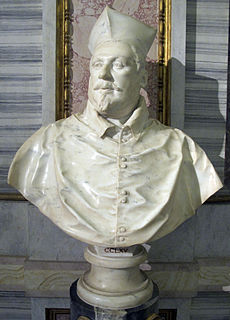
Two Busts of Cardinal Scipione Borghese are marble portrait sculptures executed by the Italian artist Gian Lorenzo Bernini in 1632. Cardinal Scipione Borghese was the nephew of Pope Paul V, and had commissioned other works from Bernini in the 1620s. Both versions of this portrait are in the Galleria Borghese, Rome.

The Lamentation of Christ is an oil-on-panel painting of the common subject of the Lamentation of Christ by the Netherlandish artist Rogier van der Weyden, dating from around 1460–1463 and now in the Uffizi Gallery, Florence, Italy.

The art collections of Fondazione Cariplo are a gallery of artworks with a significant historical and artistic value owned by Fondazione Cariplo in Italy. It consists of 767 paintings, 116 sculptures, 51 objects and furnishings dating from the 1st century to the second half of the 20th Century.

Giovanni di Bernardo Rucellai was an Italian humanist, poet, dramatist and man of letters in Renaissance Florence, in Tuscany, Italy. A member of a wealthy family of wool merchants and one of the richest men in Florence, he was cousin to Pope Leo X and linked by marriage to the powerful Strozzi and de' Medici families. He was born in Florence, and died in Rome. He was the son of Bernardo Rucellai (1448–1514) and grandson of Giovanni di Paolo Rucellai (1403–1481). He is now remembered mostly for his poem Le Api, one of the first poems composed in versi sciolti to achieve widespread acclaim.
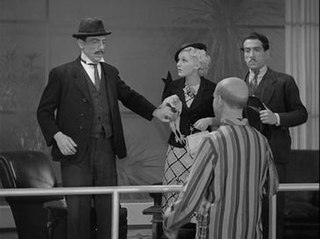
Those Two is a 1935 Italian comedy film directed by Gennaro Righelli and starring Eduardo De Filippo, Peppino De Filippo and Assia Noris. A couple of men struggling to find work both fall in love with the same woman. The story is loosely based on two works by Eduardo De Filippo.

The Archivio di Nuova Scrittura is a cultural association founded in 1988 in Milan, Italy by art collector Paolo Della Grazia. The archive preserves a large artistic and documentary heritage about any form of artistic expression featuring the use of both the word and the sign. Born from the encounter between Della Grazia and artist Ugo Carrega, in the 1990s the ANS became the main Italian research center on visual poetry, organizing exhibitions, meetings and other cultural events. In 1998 the Archivio di Nuova Scrittura was deposited in part at the Mart in Rovereto and in part at the Museion in Bozen. The artwork section of the ANS includes about 1,600 works by international artists at Mart and about 2,000 at Museion. The ANS archives preserve, apart from the internal archive of the association, the Fraccaro-Carrega fonds, containing the papers of collector Marco Fraccaro and visual poet Ugo Carrega. The library section, preserved at Mart, contains more than 18,000 volumes, among them 600 artist's books and hundreds of futurist first editions, and 600 art magazines including about 300 international artist's magazines.

Bindo Altoviti (1491–1557) of the House of Altoviti was an Italian banker and one of the most influential papal bankers of his generation. A patron of the arts, he cultivated close friendships with artists such as Benvenuto Cellini, Raphael, Michelangelo and Giorgio Vasari.

The Peddler and the Lady is a 1943 Italian comedy film directed by Mario Bonnard and starring Caterina Boratto, Cristiano Cristiani and Peppino De Filippo. The film was made at Cinecittà in Rome. Much of the film is set on the Campo de' Fiori in Rome where Elide a greengrocer is in love with a fishmonger who works nearby, but he is more interested in another woman.

Madonna and Child is a c. 1450-1455 tempera on panel painting by Filippo Lippi, now in the Magnani-Rocca Foundation in the Province of Parma in Italy. It is strongly influenced by Flemish works, particularly in the trompe-l'œil marble banister and the drape over the dark background. It also shows some similarities to the work of the Master of the Castello Nativity, who is thought to have been an assistant in Lippi's workshop.
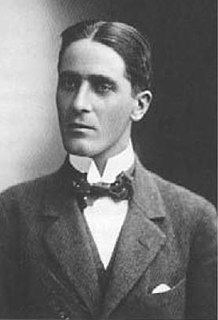
Raoul Albert La Roche was a Swiss banker and art collector. He was especially interested in purism and cubism and his collections have been donated to museums in Switzerland and France. His home in Paris, Maison La Roche, was designed by his friend Le Corbusier and now houses the Le Corbusier Foundation.



















